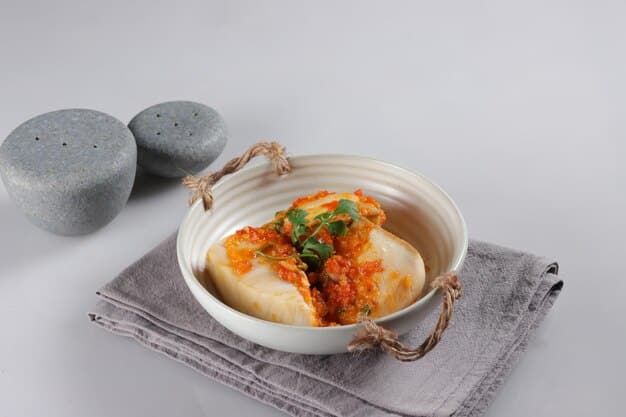K-Food Invasion: 3 Authentic Korean Recipes You Can Make at Home Tonight

Embark on a culinary adventure with “K-Food Invasion: 3 Authentic Korean Recipes You Can Make at Home Tonight,” bringing the vibrant flavors of Korea to your kitchen with easy-to-follow recipes for iconic dishes.
Craving the bold and savory flavors of Korean cuisine? Join the K-Food Invasion: 3 Authentic Korean Recipes You Can Make at Home Tonight and discover how simple it is to recreate restaurant-quality dishes in your own kitchen.
Unleash the Flavors of Korea in Your Kitchen
Korean food, or K-Food, has taken the world by storm, and for good reason! It’s a delicious blend of spicy, savory, and umami flavors that tantalizes the taste buds. But you don’t need to hop on a plane to Seoul to enjoy authentic Korean cuisine. With a few key ingredients and simple techniques, you can bring the K-Food invasion straight to your kitchen.
This article breaks down three incredible dishes that are easy to make, even for beginner cooks. Get ready to impress your friends and family with these authentic Korean flavors!
Kimchi Jjigae: A Spicy and Comforting Stew
Kimchi jjigae, or kimchi stew, is a staple in Korean households. It’s a hearty and flavorful dish that’s perfect for a cold evening or any time you’re craving something spicy and comforting. The best part? It’s incredibly easy to make!
The star of this stew is, of course, kimchi! Kimchi is a fermented cabbage dish that is packed with probiotics and flavor. The fermentation process gives it a unique sour and spicy taste that is both addictive and beneficial for your health.
Essential Ingredients for Kimchi Jjigae
Before you start cooking, make sure you have these key ingredients on hand:
- Kimchi: Use well-fermented kimchi for the best flavor.
- Pork belly or tofu: Choose your preferred protein source. Pork belly adds richness, while tofu provides a vegetarian option.
- Onion and garlic: These aromatics add depth to the stew.
- Gochujang (Korean chili paste): This is what gives the stew its signature spiciness.
- Gochugaru (Korean chili flakes): For extra heat and color.
- Dashi or chicken broth: These provide the base for the stew.
Simple Steps to Delicious Kimchi Jjigae
Follow these simple steps to create a mouthwatering kimchi jjigae:
- Sauté the pork belly or tofu in a pot until lightly browned.
- Add the onion and garlic and cook until softened.
- Stir in the kimchi, gochujang, and gochugaru.
- Pour in the dashi or chicken broth.
- Bring to a boil, then simmer for 15-20 minutes, or until the flavors meld.
- Serve hot with rice and your favorite Korean side dishes.
Kimchi jjigae is a versatile dish that can be customized to your liking. Feel free to add other vegetables like mushrooms, scallions, or zucchini. You can also adjust the amount of gochujang and gochugaru to control the spiciness level.

This flavorful stew embodies the essence of Korean comfort food. Its spicy kick and savory depth make it an unforgettable culinary experience.
Bibimbap: A Colorful and Nutritious Rice Bowl
Bibimbap, meaning “mixed rice,” is a quintessential Korean dish that’s as beautiful as it is delicious. It’s a colorful rice bowl topped with a variety of vegetables, meat, and a fried egg, all drizzled with a savory gochujang sauce. It’s a complete and balanced meal that’s sure to satisfy.
The beauty of bibimbap lies in its versatility. You can use whatever vegetables and protein you have on hand, making it a great way to use up leftovers. The gochujang sauce adds a burst of flavor that ties everything together.
Key Components of a Perfect Bibimbap Bowl
To create a truly authentic bibimbap experience, consider including these key components:
- Rice: Use cooked short-grain rice as the base.
- Protein: Marinated bulgogi (thinly sliced beef) or sautéed tofu are popular choices.
- Vegetables: Common additions include carrots, spinach, bean sprouts, mushrooms, and cucumber.
- Egg: A fried egg with a runny yolk is essential for adding richness.
- Gochujang sauce: This sweet and spicy sauce is the heart of bibimbap.
- Sesame oil: Adds a nutty aroma and flavor.
Assembling Your Own Bibimbap Masterpiece
Follow these steps to create your own customized bibimbap bowl:
- Prepare each of the vegetables by lightly sautéing or blanching them.
- Cook the protein of your choice.
- Fry an egg until the white is set and the yolk is still runny.
- Place the rice in a bowl and arrange the vegetables and protein on top.
- Place the fried egg in the center.
- Drizzle with gochujang sauce and sesame oil.
- Mix everything together before enjoying!
Bibimbap is not only delicious but also a feast for the eyes. The vibrant colors of the vegetables create a visually appealing dish that is sure to impress. Feel free to get creative with your toppings and experiment with different combinations to find your favorite bibimbap masterpiece.
This iconic dish showcases the balance and harmony of Korean cuisine, offering a blend of textures and flavors that makes every bite exciting.
Tteokbokki: Chewy Rice Cakes in Spicy Sauce
Tteokbokki, or spicy rice cakes, is a popular Korean street food that’s loved for its chewy texture and addictive spicy sauce. It’s a fun and flavorful dish that’s perfect for sharing with friends.
The key to great tteokbokki is the texture of the rice cakes. They should be soft and chewy, not mushy. The spicy sauce is made with gochujang, gochugaru, and other seasonings, and it’s what gives tteokbokki its signature flavor.
The Magic of Tteokbokki Ingredients
To make authentic tteokbokki, you’ll need these essential ingredients:
- Tteok (Korean rice cakes): Look for cylindrical rice cakes specifically made for tteokbokki.
- Gochujang (Korean chili paste): This is the base of the spicy sauce.
- Gochugaru (Korean chili flakes): Adds extra heat and color.
- Soy sauce: For umami and depth of flavor.
- Sugar: To balance the spiciness.
- Dashi or anchovy broth: Provides a flavorful base for the sauce.
- Scallions and onions: For aromatics and flavor.
- Fish cakes (optional): A popular addition for extra texture and flavor.
Crafting the Perfect Tteokbokki Experience
Follow these steps to make your own delicious tteokbokki:
- Soak the rice cakes in water to soften them.
- In a pot, combine the gochujang, gochugaru, soy sauce, sugar, and dashi or anchovy broth.
- Bring to a boil, then add the rice cakes, scallions, onions, and fish cakes (if using).
- Simmer until the rice cakes are soft and chewy and the sauce has thickened.
- Serve hot and enjoy the fiery deliciousness!
Tteokbokki is a highly customizable dish. You can add vegetables like cabbage or carrots, or even ramen noodles for a heartier meal. Adjust the amount of gochujang and gochugaru to control the spiciness level.

This popular Korean street food is a perfect combination of spicy, savory, and chewy, taking your taste buds on an exciting adventure.
Where to Find Authentic Korean Ingredients
One of the keys to making authentic Korean dishes is using the right ingredients. While some ingredients may be readily available at your local grocery store, others may require a trip to a specialty Korean market or an online retailer.
Fortunately, Korean cuisine has become so popular that many larger grocery stores now carry a selection of basic Korean ingredients. You may be able to find kimchi, gochujang, gochugaru, soy sauce, and sesame oil at your local supermarket. However, for more specialized ingredients like dashi, anchovy broth, rice cakes, and fish cakes, you may need to visit a Korean market or shop online.
Exploring Korean Markets for Culinary Treasures
Korean markets are a treasure trove of authentic ingredients and culinary inspiration. Here are some tips for navigating a Korean market:
- Don’t be afraid to ask for help: The staff at Korean markets are usually very knowledgeable and happy to assist you in finding what you need.
- Explore the banchan section: Banchan are small side dishes that are served with Korean meals. This is a great way to try new flavors and discover new favorites.
- Check the freezer section: You can often find frozen rice cakes, fish cakes, and other ingredients that may be difficult to find fresh.
- Sample the products: Many Korean markets offer samples of their products, allowing you to try before you buy.
Online Resources for Korean Cooking
If you don’t have access to a Korean market, don’t worry! There are many online retailers that specialize in Korean ingredients. Here are a few popular options:
- Amazon: A great place to find a wide variety of Korean ingredients at competitive prices.
- H Mart: A popular Korean supermarket chain with an online store that ships nationwide.
- Weee!: An online grocery delivery service that specializes in Asian foods, including Korean cuisine.
By sourcing your ingredients carefully, you can ensure that your Korean dishes are as authentic and flavorful as possible. Don’t be afraid to experiment and try new ingredients – that’s part of the fun of Korean cooking!
Mastering K-Food begins with acquiring the essential elements from trusted sources, ensuring each dish tastes authentically Korean.
Tips and Tricks for Mastering Korean Cuisine at Home
Now that you have the recipes and ingredients, let’s dive into some tips and tricks for mastering Korean cuisine at home. Whether you’re a beginner cook or an experienced chef, these tips will help you elevate your Korean cooking skills.
One of the most important things to remember is that Korean cuisine is all about balance. The flavors should be harmonious and complement each other. Don’t be afraid to experiment and adjust the recipes to your liking, but always strive for a balance of sweet, spicy, savory, and umami.
Smart Cooking Techniques for Authentic Flavors
Here are some techniques to enhance your Korean cooking:
- Marinating: Marinating meat is essential for Korean cuisine. It tenderizes the meat and infuses it with flavor. Allow the meat to marinate for at least 30 minutes, or preferably overnight, for the best results.
- Fermenting: Fermented foods like kimchi and doenjang (fermented soybean paste) are a cornerstone of Korean cuisine. Don’t be afraid to embrace the funky flavors of fermented foods – they add a unique depth of flavor to your dishes.
- Proper Knife Skills: Slicing and dicing like a pro can significantly improve your dishes. For example, uniformly sliced vegetables cook evenly and create a more appealing presentation.
Adjusting Spiciness Levels
Not everyone can handle the heat! If you’re sensitive to spice, here’s how to adjust the spiciness level of your Korean dishes:
- Start with less gochujang and gochugaru: You can always add more, but you can’t take it away.
- Use a sweetener: Sugar, honey, or maple syrup can help balance the spiciness.
- Add dairy: Milk, yogurt, or cheese can help cool down the heat.
With these tips and tricks, you’ll be well on your way to mastering Korean cuisine at home. Remember to have fun, experiment, and most importantly, enjoy the delicious flavors of Korea!
Success in Korean cooking lies in understanding traditional techniques and flavour adaptation, customizing each recipe to personal preferences.
The Health Benefits of K-Food
Beyond its delicious flavors, Korean food offers a wealth of health benefits. From fermented foods packed with probiotics to colorful vegetables rich in vitamins and minerals, K-Food is a nutritious and wholesome cuisine.
One of the biggest health benefits of Korean food is its emphasis on fermented foods. Kimchi, doenjang, and gochujang are all fermented, which means they are packed with probiotics. Probiotics are beneficial bacteria that support gut health, boost immunity, and improve digestion.
Nutritional Powerhouses in Korean Dishes
Here’s why Korean food is good for you:
- Kimchi: Rich in probiotics and vitamins. Enhances gut health and immunity.
- Bibimbap: A balanced mix of carbs, proteins, and veggies. Provides sustained energy and essential nutrients.
- Tteokbokki: While spicy, the rice cakes are low in fat and provide a good source of carbohydrates.
Korean cuisine offers a delightful and healthful way to enjoy diverse, nutrient-rich foods. The variety of ingredients and cooking methods cater to a balanced and vibrant diet.
Embrace the wholesome aspect of K-Food for a tasty and health-conscious culinary experience.
| Key Point | Brief Description |
|---|---|
| 🌶️ Kimchi Jjigae | Spicy kimchi stew, perfect for cold days. |
| 🍚 Bibimbap | Colorful mixed rice bowl with veggies and protein. |
| 🍥 Tteokbokki | Chewy rice cakes in spicy and sweet sauce. |
| 🛒 Ingredients | Find authentic ingredients at Korean markets or online. |
Frequently Asked Questions About Korean Recipes
▼
Gochujang is a thick, spicy, and savory Korean paste made from red chili powder, glutinous rice, fermented soybeans, and salt. It’s a key ingredient in many Korean dishes and adds a deep, complex flavor.
▼
Yes, you can! Simply substitute the pork belly with firm tofu or mushrooms. You can also use vegetable broth instead of chicken or dashi broth for a fully vegetarian version.
▼
If you can’t find Gochugaru, you can use a combination of regular chili flakes and a touch of paprika to mimic the color and mild heat. However, the flavor won’t be exactly the same.
▼
Store leftover Tteokbokki in an airtight container in the refrigerator for up to 2 days. When reheating, add a splash of water to prevent the rice cakes from drying out. You can microwave it or reheat it on the stovetop.
▼
Common Banchan include kimchi, seasoned spinach (Sigeumchi Namul), pickled radish (Danmuji), and seasoned bean sprouts (Kongnamul Muchim). These small side dishes add variety and balance to the meal.
Conclusion
With these three authentic Korean recipes, you’re now equipped to embark on your own K-Food culinary adventure. Each dish offers a unique flavor profile and a taste of Korea’s rich culinary heritage, all easily achievable in your home kitchen. So, gather your ingredients, put on some K-Pop, and get ready to savor the delicious world of Korean cuisine!





